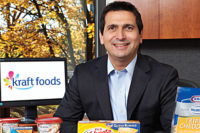The World Trade Organization's Doha Round negotiations are devilish talks indeed.
The Round, launched in September 2001 with a mandate to liberalize agriculture trade, is a complex undertaking: getting 148 countries to agree on how much to their subsidies and tariffs, how fast, has been a shuffling, challenging process. Back in Doha, the group agreed to eliminate export subsidies and harmonize market access barriers and domestic support levels. Left for dead several times (remember Seattle? Or Cancun?), the Round remains alive by hitting small, incremental deadlines just often enough to claim progress.
"Unfortunately, that's how trade negotiations work," explains Tom Suber, president of the U.S. Dairy Export Council. "The Uruguay Round took seven years to complete. Countless deadlines were missed. But at the end of the day, we came away with an agreement that has had a beneficial impact."
This fall is another key period. The former chairman of the agricultural negotiations had targeted the end of July to have a "first approximation" of a "framework" for reform, but consensus couldn't be reached. Officials will continue discussions over the next few months, working towards crafting those elusive "modalities" at the Sixth Ministerial Conference in Hong Kong, Dec. 13-18. If they can do that, countries would then have 12 months to shape the details and specific timeframes to meet the drop-dead completion deadline of December 2006.
Yet there are many details still to be settled. Since spring, trade reps have been focusing on solving the puzzle of harmonizing market access; that is, how to even out the morass of tariffs and quotas that make some countries relatively open while others remain effectively closed.
"Europe, Japan and Canada still maintain triple-digit tariff rates on dairy products," says Suber. "The U.S. dairy industry's goal in the Doha Round is to level the playing field and the best way to do that is to take deeper cuts in the high tariff rates and relatively smaller cuts in the low tariff rates."
Market access is currently the stickiest of the three "pillars" on which the negotiations sit. Negotiations are clearer on the other two "pillars": export competition and domestic support.
"Elimination of export subsidies is certainly one of our main priorities in this Round," Suber says. "The European Union provides in excess of $1 billion in dairy export subsidies each year, more than 100 times what the United States is allowed to spend. This has a serious, distorting effect on world dairy markets that must be corrected."
In preliminary talks, Europe has agreed to eliminate its export subsidies, but it wants the United States to do the same with export credit and food aid - though large elements of those programs don't distort trade and are not opposed by other WTO members. The exact timetable for reductions has yet to be determined.
Likewise, on domestic support, the United States says it is committed to meaningful reform of its own support programs if Europe and others do likewise.
"All three elements are interrelated," Suber says. "Success requires balanced progress on all three fronts."
So what does the U.S. dairy industry have to gain by taking a proactive approach to world trade talks?
"We're trying to correct some of the disparities in trading rules left over from the Uruguay Round. The U.S. dairy industry has the ability to be a competitive supplier - but we need to all be playing by similar rules," Suber explains.
"We learned from the Uruguay talks that we have to be involved in the negotiating process."


